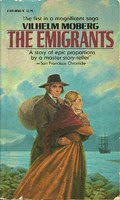1940
For Whom the Bell Tolls by Ernest Hemingway
1941
The Black Stallion by Walter Farley
1942
The Body in the Library* by Agatha Christie
1943
The Fountainhead by Ayn Rand
Hungry Hill* by Daphne du Maurier
The Moving Finger by Agatha Christie
A Tree Grows in Brooklyn* by Betty Smith
1944
Gigi* by Colette
1945
The Ghost and Mrs. Muir by Josephine Leslie/ RA Dick
Pippi Longstocking by Astrid Lindgren
Village in the Sun by Dane Chandos
1946
Mr. Blandings Builds His Dream House by Eric Hodgins
1947
Gentleman's Agreement by Laura Z. Hobson
1948
Maigret's First Case by Georges Simenon
1949
Nineteen Eighty-Four by George Orwell
No Boats on Bannermere by Geofrey Trease
Sunday, August 24, 2014
Saturday, August 23, 2014
Village in the Sun (1945)
This book is about Ajijic, a small village situated between a lake and a mountain, found within close distance to the larger Chapala and the even larger Guadalajara. Currently, Ajijic is a thriving expat community full of Americans and Canadians, but in 1945, when Village in the Sun was first published Ajijic was a remote, hard-to-reach pueblo accessible easiest by water. The author Dane Chandos (a pseudonym for Peter Lilley, Nigel Millet, and Anthony Stansfield) was one of the area's earliest foreign residents.
Very little happens in this book. The writing is heavily descriptive about birds, dogs, the water, light, sunsets, fruit, and flowers. It's a beautiful night-time read, very painterly and restful, right before you go to sleep. A paradise of Eden in print.
The narrator, known only as el Señor, is kind but remote to the story's plot. He is primarily an observer. The real characters are the Indios: Candelaria the cook, Cayetano el mozo (a joven/youth with butler duties), Don Bernabe the builder, and to a lesser degree many others including the three seamstress sisters, Aurora the laundry woman with a sour face, and the revolving maids who work together to keep the position filled. While the Indios may be antiquated in practice, their dialogue is translated with an elegance reminiscent of Shakespearean English. Chandos clearly has respect for the culture in which he lives and writes. El Senor's visitors are not quite as accepting, though. Some of the Europeans who breeze through the small town and some of the big-city Mexicans are condescending and rude. Social class is definitely an issue in 1940s Mexico and the external world is moving in. At the end of the novel, the presence of a powerboat on the lake sums it up. Mexico is changing. And so is Ajijic. The future of the small village is foreshadowed by Don Pedro who takes a loss every year in anticipation of the time when Ajijic will become a resort town with conveniences. That time is now.
Very little happens in this book. The writing is heavily descriptive about birds, dogs, the water, light, sunsets, fruit, and flowers. It's a beautiful night-time read, very painterly and restful, right before you go to sleep. A paradise of Eden in print.
The narrator, known only as el Señor, is kind but remote to the story's plot. He is primarily an observer. The real characters are the Indios: Candelaria the cook, Cayetano el mozo (a joven/youth with butler duties), Don Bernabe the builder, and to a lesser degree many others including the three seamstress sisters, Aurora the laundry woman with a sour face, and the revolving maids who work together to keep the position filled. While the Indios may be antiquated in practice, their dialogue is translated with an elegance reminiscent of Shakespearean English. Chandos clearly has respect for the culture in which he lives and writes. El Senor's visitors are not quite as accepting, though. Some of the Europeans who breeze through the small town and some of the big-city Mexicans are condescending and rude. Social class is definitely an issue in 1940s Mexico and the external world is moving in. At the end of the novel, the presence of a powerboat on the lake sums it up. Mexico is changing. And so is Ajijic. The future of the small village is foreshadowed by Don Pedro who takes a loss every year in anticipation of the time when Ajijic will become a resort town with conveniences. That time is now.
Labels:
books,
visit mexico
Subscribe to:
Posts (Atom)



